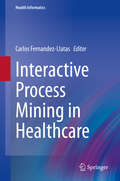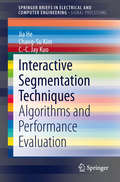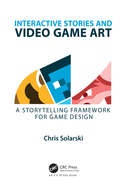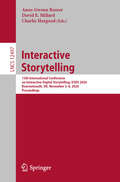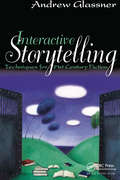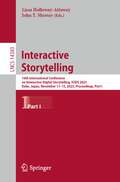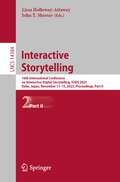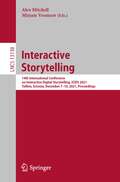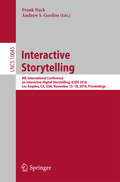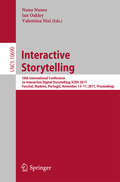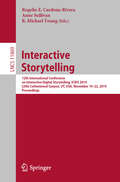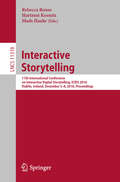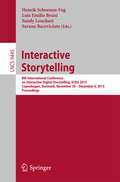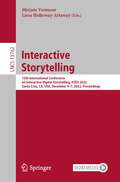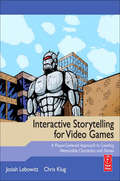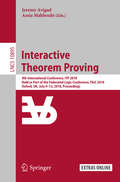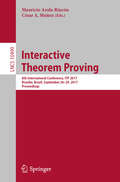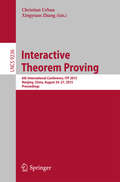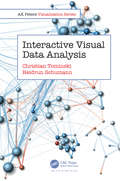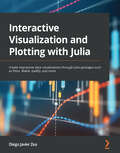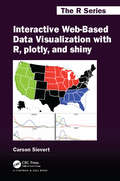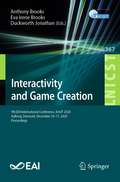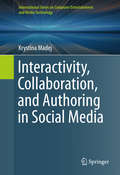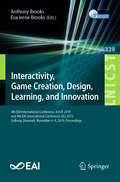- Table View
- List View
Interactive Process Mining in Healthcare (Health Informatics)
by Carlos Fernandez-LlatasThis book provides a practically applicable guide to the methodologies and technologies for the application of interactive process mining paradigm. Case studies are presented where this paradigm has been successfully applied in emergency medicine, surgery processes, human behavior modelling, strokes and outpatients’ services, enabling the reader to develop a deep understanding of how to apply process mining technologies in healthcare to support them in inferring new knowledge from past actions, and providing accurate and personalized knowledge to improve their future clinical decision-making. Interactive Process Mining in Healthcare comprehensively covers how machine learning algorithms can be utilized to create real scientific evidence to improve daily healthcare protocols, and is a valuable resource for a variety of health professionals seeking to develop new methods to improve their clinical decision-making.
Interactive Segmentation Techniques: Algorithms and Performance Evaluation
by Jia He C.-C. Jay Kuo Chang-Su KimThis book focuses on interactive segmentation techniques, which have been extensively studied in recent decades. Interactive segmentation emphasizes clear extraction of objects of interest, whose locations are roughly indicated by human interactions based on high level perception. This book will first introduce classic graph-cut segmentation algorithms and then discuss state-of-the-art techniques, including graph matching methods, region merging and label propagation, clustering methods, and segmentation methods based on edge detection. A comparative analysis of these methods will be provided with quantitative and qualitative performance evaluation, which will be illustrated using natural and synthetic images. Also, extensive statistical performance comparisons will be made. Pros and cons of these interactive segmentation methods will be pointed out, and their applications will be discussed. There have been only a few surveys on interactive segmentation techniques, and those surveys do not cover recent state-of-the art techniques. By providing comprehensive up-to-date survey on the fast developing topic and the performance evaluation, this book can help readers learn interactive segmentation techniques quickly and thoroughly.
Interactive Stories and Video Game Art: A Storytelling Framework for Game Design
by Chris SolarskiThe success of storytelling in games depends on the entire development team—game designers, artists, writers, programmers and musicians, etc.—working harmoniously together towards a singular artistic vision. Interactive Stories and Video Game Art is first to define a common design language for understanding and orchestrating interactive masterpieces using techniques inherited from the rich history of art and craftsmanship that games build upon. Case studies of hit games like The Last of Us, Journey, and Minecraft illustrate the vital components needed to create emotionally-complex stories that are mindful of gaming’s principal relationship between player actions and video game aesthetics. This book is for developers of video games and virtual reality, filmmakers, gamification and transmedia experts, and everybody else interested in experiencing resonant and meaningful interactive stories. Key Features: The first book to define a common visual and interactive language for understanding and orchestrating sophisticated stories in video games Accessible to industry professionals as well as non-developers Featured concepts apply to all media with an interactive component including: transmedia, gamification and interactive art The definitive framework for designing interactive stories
Interactive Storytelling: 13th International Conference on Interactive Digital Storytelling, ICIDS 2020, Bournemouth, UK, November 3–6, 2020, Proceedings (Lecture Notes in Computer Science #12497)
by Anne-Gwenn Bosser David E. Millard Charlie HargoodThis book constitutes the refereed proceedings of the 13th International Conference on Interactive Digital Storytelling, ICIDS 2020, held in Bournemouth, UK, in November 2020. The 15 full papers and 8 short papers presented together with 5 posters, were carefully reviewed and selected from 70 submissions. The conference offers topics in game narrative and interactive storytelling, including the theoretical, technological, and applied design practices, narrative systems, storytelling technology, and humanities-inspired theoretical inquiry, empirical research and artistic expression.
Interactive Storytelling: Techniques for 21st Century Fiction
by Andrew GlassnerWe are on the verge of creating an exciting new kind of interactive story form that will involve audiences as active participants. This book provides a solid foundation in the fundamentals of classical story structure and classical game structure and explains why it has been surprisingly difficult to bring these two activities together. With this foundation in place, the book presents several ideas for ways to move forward in this appealing quest. The author has a conversational and friendly style, making reading a pleasure.
Interactive Storytelling: 16th International Conference on Interactive Digital Storytelling, ICIDS 2023, Kobe, Japan, November 11–15, 2023, Proceedings, Part I (Lecture Notes in Computer Science #14383)
by Lissa Holloway-Attaway John T. MurrayThis two-volume set LNCS 14383 and LNCS 14384 constitutes the refereed proceedings of the 16th International Conference on Interactive Digital Storytelling, ICIDS 2023, held in Kobe, Japan, during November 11–15, 2023. The 30 full papers presented in this book together with 11 short papers were carefully reviewed and selected from 101 submissions. Additionally, the proceedings includes 22 Late Breaking Works. The papers focus on topics such as: theory, history and foundations; social and cultural contexts; tools and systems; interactive narrative design; virtual worlds, performance, games and play; applications and case studies; and late breaking works.
Interactive Storytelling: 16th International Conference on Interactive Digital Storytelling, ICIDS 2023, Kobe, Japan, November 11–15, 2023, Proceedings, Part II (Lecture Notes in Computer Science #14384)
by Lissa Holloway-Attaway John T. MurrayThis two-volume set LNCS 14383 and LNCS 14384 constitutes the refereed proceedings of the 16th International Conference on Interactive Digital Storytelling, ICIDS 2023, held in Kobe, Japan, during November 11–15, 2023.The 30 full papers presented in this book together with 11 short papers were carefully reviewed and selected from 101 submissions. Additionally, the proceedings includes 22 Late Breaking Works.The papers focus on topics such as: theory, history and foundations; social and cultural contexts; tools and systems; interactive narrative design; virtual worlds, performance, games and play; applications and case studies; and late breaking works.
Interactive Storytelling: 14th International Conference on Interactive Digital Storytelling, ICIDS 2021, Tallinn, Estonia, December 7–10, 2021, Proceedings (Lecture Notes in Computer Science #13138)
by Alex Mitchell Mirjam VosmeerThis book constitutes the refereed proceedings of the 14th International Conference on Interactive Digital Storytelling, ICIDS 2021, held in Tallinn, Estonia, in December 2021. The 18 full papers and 17 short papers, presented together with 17 posters and demos, were carefully reviewed and selected from 99 submissions. The papers are categorized into the following topical sub-headings: Narrative Systems; Interactive Narrative Theory; Interactive Narrative Impact and Application; and the Interactive Narrative Research Discipline and Contemporary Practice.
Interactive Storytelling
by Frank Nack Andrew S. GordonThis book constitutes the refereed proceedings of the 9th International Conference on Interactive Digital Storytelling, ICIDS 2016, held in Los Angeles, CA, USA, in November 2016. The 26 revised full papers and 8 short papers presented together with 9 posters, 4 workshop, and 3 demonstration papers were carefully reviewed and selected from 88 submissions. The papers are organized in topical sections on analyses and evaluation systems; brave new ideas; intelligent narrative technologies; theoretical foundations; and usage scenarios and applications.
Interactive Storytelling: 9th International Conference on Interactive Digital Storytelling, ICIDS 2016, Los Angeles, CA, USA, November 15–18, 2016, Proceedings (Lecture Notes in Computer Science #10045)
by Frank Nack Andrew S. GordonThis book constitutes the refereed proceedings of the 9th International Conference on Interactive Digital Storytelling, ICIDS 2016, held in Los Angeles, CA, USA, in November 2016. The 26 revised full papers and 8 short papers presented together with 9 posters, 4 workshop, and 3 demonstration papers were carefully reviewed and selected from 88 submissions. The papers are organized in topical sections on analyses and evaluation systems; brave new ideas; intelligent narrative technologies; theoretical foundations; and usage scenarios and applications.
Interactive Storytelling: 10th International Conference on Interactive Digital Storytelling, ICIDS 2017 Funchal, Madeira, Portugal, November 14–17, 2017, Proceedings (Lecture Notes in Computer Science #10690)
by Nuno Nunes, Ian Oakley and Valentina NisiThis book constitutes the refereed proceedings of the 10th International Conference on Interactive Digital Storytelling, ICIDS 2017, held in Funchal, Madeira, Portugal, in November 2017. The 16 revised full papers and 4 short papers presented were carefully reviewed and selected from 65 submissions. The papers are organized in topical sections on story design, location and generation, history and learning, games, emotion and personality, posters and demos.
Interactive Storytelling: 12th International Conference on Interactive Digital Storytelling, ICIDS 2019, Little Cottonwood Canyon, UT, USA, November 19–22, 2019, Proceedings (Lecture Notes in Computer Science #11869)
by Rogelio E. Cardona-Rivera Anne Sullivan R. Michael YoungThis book constitutes the refereed proceedings of the 12th International Conference on Interactive Digital Storytelling, ICIDS 2019, held in Little Cottonwood Canyon, UT, USA, in November 2019. The 14 revised full papers and 10 short papers presented together with 19 posters, 1 demo, and 3 doctoral consortiums were carefully reviewed and selected from 66 submissions. The papers are organized in the following topical sections: Creating the Discipline: Interactive Digital Narrative Studies, Impacting Culture and Society, Interactive Digital Narrative Practices and Applications, Theoretical Foundations, Technologies, Human Factors, Doctoral Consortium, and Demonstrations.
Interactive Storytelling: 11th International Conference on Interactive Digital Storytelling, ICIDS 2018, Dublin, Ireland, December 5–8, 2018, Proceedings (Lecture Notes in Computer Science #11318)
by Rebecca Rouse Hartmut Koenitz Mads HaahrThis book constitutes the refereed proceedings of the 11th International Conference on Interactive Digital Storytelling, ICIDS 2018, held in Dublin, Ireland, in December 2018. The 20 revised full papers and 16 short papers presented together with 17 posters, 11 demos, and 4 workshops were carefully reviewed and selected from 56, respectively 29, submissions. The papers are organized in the following topical sections: the future of the discipline; theory and analysis; practices and games; virtual reality; theater and performance; generative and assistive tools and techniques; development and analysis of authoring tools; and impact in culture and society.
Interactive Storytelling
by Henrik Schoenau-Fog Luis Emilio Bruni Sandy Louchart Sarune BaceviciuteThis book constitutes the refereed proceedings of the 8th International Conference on Interactive Digital Storytelling, ICIDS 2015, held in Copenhagen, Denmark, in November/December 2015. The 18 revised full papers and 13 short papers presented together with 9 posters, 9 workshop descriptions, and 3 demonstration papers were carefully reviewed and selected from 80 submissions. The papers are organized in topical sections on theoretical and design foundations, technical advances, analyses and evaluation systems, and current and future usage scenarios and applications.
Interactive Storytelling: 15th International Conference on Interactive Digital Storytelling, ICIDS 2022, Santa Cruz, CA, USA, December 4–7, 2022, Proceedings (Lecture Notes in Computer Science #13762)
by Mirjam Vosmeer Lissa Holloway-AttawayThis book constitutes the refereed proceedings of the 15th International Conference on Interactive Digital Storytelling, ICIDS 2022, held in Santa Cruz, CA, USA, in December 2022.The 30 full papers and 10 short papers, presented together with 17 posters and demos, were carefully reviewed and selected from 79 submissions.
Interactive Storytelling for Video Games: Proven Writing Techniques for Role Playing Games, Online Games, First Person Shooters, and more
by Chris Klug Josiah LebowitzWhat really makes a video game story interactive? What's the best way to create an interactive story?How much control should players be given? Do they really want that control in the first place?Do they even know what they want-or are their stated desires at odds with the unconscious preferences?All of these questions and more are examined in this definitive book on interactive storytelling for video games. You'll get detailed descriptions of all major types of interactive stories, case studies of popular games (including Bioshock, Fallout 3, Final Fantasy XIII, Heavy Rain, and Metal Gear Solid), and how players interact with them, and an in-depth analysis of the results of a national survey on player storytelling preferences in games. You'll get the expert advice you need to generate compelling and original game concepts and narratives.With Interactive Storytelling for Video Games, you'll:
Interactive Theorem Proving: 9th International Conference, ITP 2018, Held as Part of the Federated Logic Conference, FloC 2018, Oxford, UK, July 9-12, 2018, Proceedings (Lecture Notes in Computer Science #10895)
by Jeremy Avigad Assia MahboubiThis book constitutes the refereed proceedings of the 9th International Conference on Interactive Theorem Proving, ITP 2018, held in Oxford, UK, in July 2018.The 32 full papers and 5 short papers presented were carefully reviewed and selected from 65 submissions. The papers feature research in the area of logical frameworks and interactive proof assistants. The topics include theoretical foundations and implementation aspects of the technology, as well as applications to verifying hardware and software systems to ensure their safety and security, and applications to the formal verication of mathematical results.Chapters 2, 10, 26, 29, 30 and 37 are available open access under a Creative Commons Attribution 4.0 International License via link.springer.com.
Interactive Theorem Proving
by Mauricio Ayala-Rincón César A. MuñozThis book constitutes the refereed proceedings of the 8th International Conference on Interactive Theorem Proving, ITP 2017, held in Brasilia, Brazil, in September 2017. The 28 full papers, 2 rough diamond papers, and 3 invited talk papers presented were carefully reviewed and selected from 65 submissions. The topics range from theoretical foundations to implementation aspects and applications in program verification, security and formalization of mathematical theories.
Interactive Theorem Proving
by Christian Urban Xingyuan ZhangThis book constitutes the proceedings of the 6th International Conference on Interactive Theorem Proving, ITP 2015, held in Nanjing, China, in August 2015. The 27 papers presented in this volume were carefully reviewed and selected from 54 submissions. The topics range from theoretical foundations to implementation aspects and applications in program verification, security and formalization of mathematics.
Interactive Visual Data Analysis (AK Peters Visualization Series)
by Christian Tominski Heidrun SchumannIn the age of big data, being able to make sense of data is an important key to success. Interactive Visual Data Analysis advocates the synthesis of visualization, interaction, and automatic computation to facilitate insight generation and knowledge crystallization from large and complex data. The book provides a systematic and comprehensive overview of visual, interactive, and analytical methods. It introduces criteria for designing interactive visual data analysis solutions, discusses factors influencing the design, and examines the involved processes. The reader is made familiar with the basics of visual encoding and gets to know numerous visualization techniques for multivariate data, temporal data, geo-spatial data, and graph data. A dedicated chapter introduces general concepts for interacting with visualizations and illustrates how modern interaction technology can facilitate the visual data analysis in many ways. Addressing today’s large and complex data, the book covers relevant automatic analytical computations to support the visual data analysis. The book also sheds light on advanced concepts for visualization in multi-display environments, user guidance during the data analysis, and progressive visual data analysis. The authors present a top-down perspective on interactive visual data analysis with a focus on concise and clean terminology. Many real-world examples and rich illustrations make the book accessible to a broad interdisciplinary audience from students, to experts in the field, to practitioners in data-intensive application domains. Features: Dedicated to the synthesis of visual, interactive, and analysis methods Systematic top-down view on visualization, interaction, and automatic analysis Broad coverage of fundamental and advanced visualization techniques Comprehensive chapter on interacting with visual representations Extensive integration of automatic computational methods Accessible portrayal of cutting-edge visual analytics technology Foreword by Jack van Wijk For more information, you can also visit the author website, where the book's figures are made available under the CC BY Open Access license.
Interactive Visualization and Plotting with Julia: Create impressive data visualizations through Julia packages such as Plots, Makie, Gadfly, and more
by Diego Javier ZeaRepresent and analyze data using Plots to find actionable insights using Julia programmingKey FeaturesLearn to use static and interactive plots to explore data with JuliaBecome well versed with the various plotting attributes needed to customize your plotsCreate insightful and appealing plots using data interactions, animations, layouts, and themesBook DescriptionThe Julia programming language offers a fresh perspective into the data visualization field.Interactive Visualization and Plotting with Julia begins by introducing the Julia language and the Plots package. The book then gives a quick overview of the Julia plotting ecosystem to help you choose the best library for your task. In particular, you will discover the many ways to create interactive visualizations with its packages. You'll also leverage Pluto notebooks to gain interactivity and use them intensively through this book. You'll find out how to create animations, a handy skill for communication and teaching. Then, the book shows how to solve data analysis problems using DataFrames and various plotting packages based on the grammar of graphics. Furthermore, you'll discover how to create the most common statistical plots for data exploration. Also, you'll learn to visualize geographically distributed data, graphs and networks, and biological data. Lastly, this book will go deeper into plot customizations with Plots, Makie, and Gadfly—focusing on the former—teaching you to create plot themes, arrange multiple plots into a single figure, and build new plot types.By the end of this Julia book, you'll be able to create interactive and publication-quality static plots for data analysis and exploration tasks using Julia.What you will learnCreate interactive plots with Makie, Plots, Jupyter, and PlutoCreate standard statistical plots and visualize clustering resultsPlot geographically distributed and biological dataVisualize graphs and networks using GraphRecipes and GraphPlotsFind out how to draw and animate objects with Javis, Plots, and MakieDefine plot themes to reuse plot visual aspect customizationsArrange plots using Plots, Makie, and Gadfly layout systemsDefine new plot types and determine how Plots and Makie show objectsWho this book is forData analysts looking to explore Julia's data visualization capabilities will find this book helpful, along with scientists and academics who want to generate and communicate knowledge and improve their teaching material. This data visualization book will also interest Julia programmers willing to delve into the language plotting ecosystem and improve their visualization skills. Basic programming knowledge is assumed — but the book will introduce you to Julia's important features. Familiarity with mathematical and statistical concepts will help you make the most of some of the chapters.
Interactive Web-Based Data Visualization with R, plotly, and shiny (Chapman & Hall/CRC The R Series)
by Carson SievertThe richly illustrated Interactive Web-Based Data Visualization with R, plotly, and shiny focuses on the process of programming interactive web graphics for multidimensional data analysis. It is written for the data analyst who wants to leverage the capabilities of interactive web graphics without having to learn web programming. Through many R code examples, you will learn how to tap the extensive functionality of these tools to enhance the presentation and exploration of data. By mastering these concepts and tools, you will impress your colleagues with your ability to quickly generate more informative, engaging, and reproducible interactive graphics using free and open source software that you can share over email, export to pdf, and more. Key Features: Convert static ggplot2 graphics to an interactive web-based form Link, animate, and arrange multiple plots in standalone HTML from R Embed, modify, and respond to plotly graphics in a shiny app Learn best practices for visualizing continuous, discrete, and multivariate data Learn numerous ways to visualize geo-spatial data This book makes heavy use of plotly for graphical rendering, but you will also learn about other R packages that support different phases of a data science workflow, such as tidyr, dplyr, and tidyverse. Along the way, you will gain insight into best practices for visualization of high-dimensional data, statistical graphics, and graphical perception. The printed book is complemented by an interactive website where readers can view movies demonstrating the examples and interact with graphics.
Interactivity and Game Creation: 9th EAI International Conference, ArtsIT 2020, Aalborg, Denmark, December 10–11, 2020, Proceedings (Lecture Notes of the Institute for Computer Sciences, Social Informatics and Telecommunications Engineering #367)
by Anthony Brooks Eva Irene Brooks Duckworth JonathanThis book constitutes the refereed post-conference proceedings of the 9th International Conference on Interactivity and Game Creation, ArtsIT 2020, held in Aalborg, Denmark, in December 2020. Due to COVID-19 pandemic the conference was held virtually. The 28 revised full papers presented were carefully selected from 60 submissions. The papers represent a forum for the dissemination of cutting-edge research results in the area of arts, design and technology, including open related topics like interactivity and game creation. They are grouped in terms of content on art, installation and performance; games; design; intelligence and creativity in healthcare; wellbeing and aging.
Interactivity, Collaboration, and Authoring in Social Media
by Krystina MadejThis book includes a short history of interactive narrative and an account of a small group collaboratively authored social media narrative: Romeo and Juliet on Facebook: After Love Comes Destruction. At the forefront of narrative innovation are social media channels - speculative spaces for creating and experiencing stories that are interactive and collaborative. Media, however, is only the access point to the expressiveness of narrative content. Wikis, messaging, mash-ups, and social media (Facebook, Twitter, YouTube and others) are on a trajectory of participatory story creation that goes back many centuries. These forms offer authors ways to create narrative meaning that reflects our current media culture, as the harlequinade reflected the culture of the 18th century, and as the volvelle reflected that of the 13th century. Interactivity, Collaboration, and Authoring in Social Media first prospects the last millennium for antecedents of today's authoring practices. It does so with a view to considering how today's digital manifestations are a continuation, perhaps a reiteration, perhaps a novel pioneering, of humans' abiding interest in interactive narrative. The book then takes the reader inside the process of creating a collaborative, interactive narrative in today's social media through an authoring experience undertaken by a group of graduate students. The engaging mix of blogs, emails, personal diaries , and fabricated documents used to create the narrative demonstrates that a social media environment can facilitate a meaningful and productive collaborative authorial experience and result in an abundance of networked, personally expressive, and visually and textually referential content. The resulting narrative, After Love Comes Destruction, based in Shakespeare's Romeo and Juliet, shows how a generative narrative space evolved around the students' use of social media in ways they had not previously considered both for authoring and for delivery of their final narrative artifact.
Interactivity, Game Creation, Design, Learning, and Innovation: 8th EAI International Conference, ArtsIT 2019, and 4th EAI International Conference, DLI 2019, Aalborg, Denmark, November 6–8, 2019, Proceedings (Lecture Notes of the Institute for Computer Sciences, Social Informatics and Telecommunications Engineering #328)
by Anthony Brooks Eva Irene BrooksThis book constitutes the refereed post-conference proceedings of two conferences: The 8th EAI International Conference on ArtsIT, Interactivity and Game Creation (ArtsIT 2019), and the 4th EAI International Conference on Design, Learning, and Innovation (DLI 2019). Both conferences were hosed in Aalborg, Denmark, and took place November 6-8, 2019. The 61 revised full papers presented were carefully selected from 98 submissions. The papers represent a forum for the dissemination of cutting-edge research results in the area of arts, design and technology, including open related topics like interactivity and game creation.
